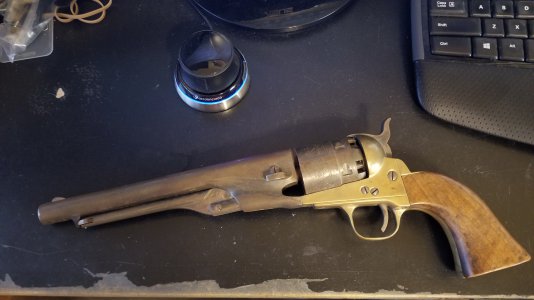- Joined
- Jul 7, 2020
- Messages
- 71
A good alternative to a caustic hot dip blue is the old Belgium Bluing. You can purchase this at Brownells and it can be done on the kitchen stove with a suitable tank large enough to boil the water and gun parts. It will give a nice soft blue which is a close match to the finishes used by companies such as Remington in the 19th century. Personally I don't like the hot dip blues as they look too metallic and don't replicate the original finishes well unless you do a bead blast ahead of time.
For future reference try to avoid using any type of buffing wheel when polishing gun parts like this. The problem with a buffing wheel is that it will (without extreme care) round edges over that are supposed to be sharp, dish out screw holes, and when used too aggressively leave a rippled surface. If the surface is round and you have already pre-polished it by hand a buffing wheel can be used to good effect to lightly (and I do mean lightly) hit the surface but even there I find sandpaper and appropriate blocks can do as good a job. Polishing can be a slow, tedious process, but there aren't too many shortcuts that will still produce a quality job. Do the initial prep with a few good, fine cut files to remove tooling marks, and stampings and finish with a good wet/dry sandpaper, blocks cut to contour to surfaces for backing, and a lot of elbow grease. Work your way up from about 120 to 400 for a good professional looking job. Some go higher, but this has generally been my stopping point. I add a couple pieces of Scotchbrite to rub out the sanding marks when I am done and let me know what areas still need more attention.
For future reference try to avoid using any type of buffing wheel when polishing gun parts like this. The problem with a buffing wheel is that it will (without extreme care) round edges over that are supposed to be sharp, dish out screw holes, and when used too aggressively leave a rippled surface. If the surface is round and you have already pre-polished it by hand a buffing wheel can be used to good effect to lightly (and I do mean lightly) hit the surface but even there I find sandpaper and appropriate blocks can do as good a job. Polishing can be a slow, tedious process, but there aren't too many shortcuts that will still produce a quality job. Do the initial prep with a few good, fine cut files to remove tooling marks, and stampings and finish with a good wet/dry sandpaper, blocks cut to contour to surfaces for backing, and a lot of elbow grease. Work your way up from about 120 to 400 for a good professional looking job. Some go higher, but this has generally been my stopping point. I add a couple pieces of Scotchbrite to rub out the sanding marks when I am done and let me know what areas still need more attention.


